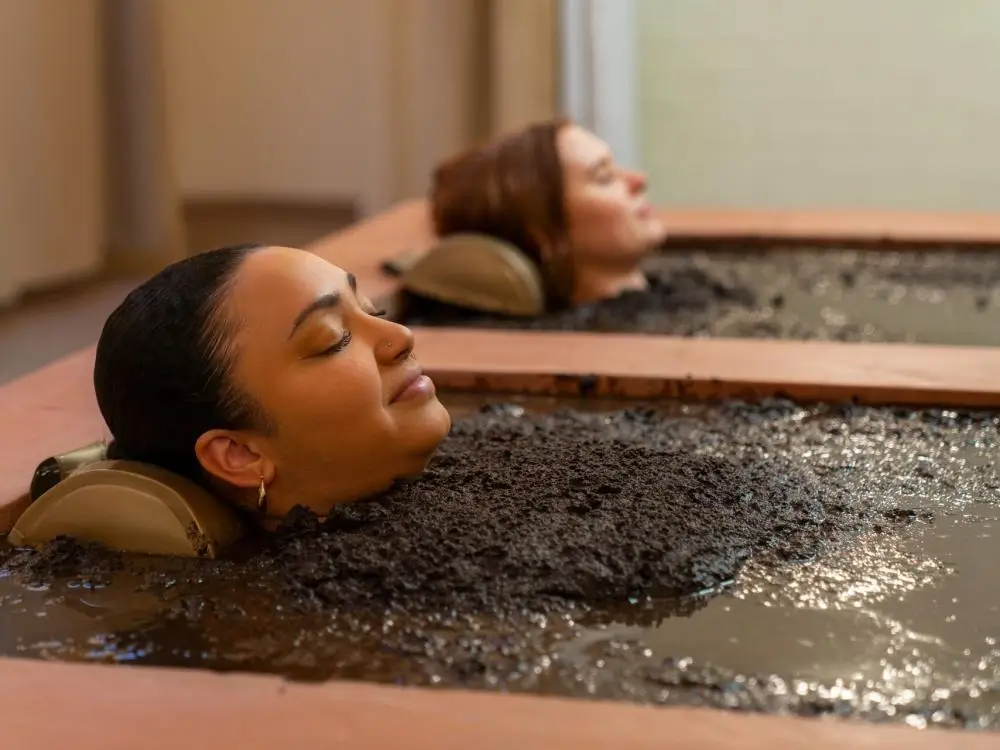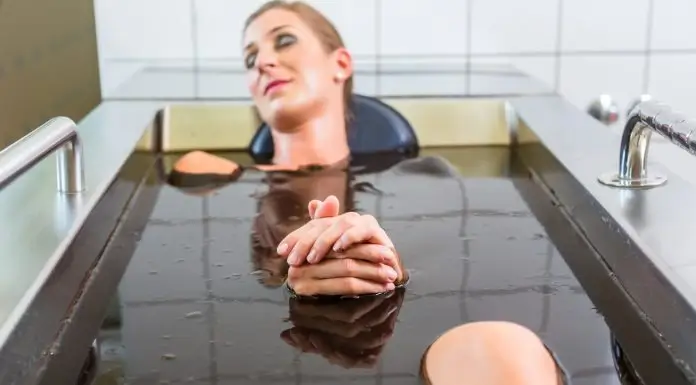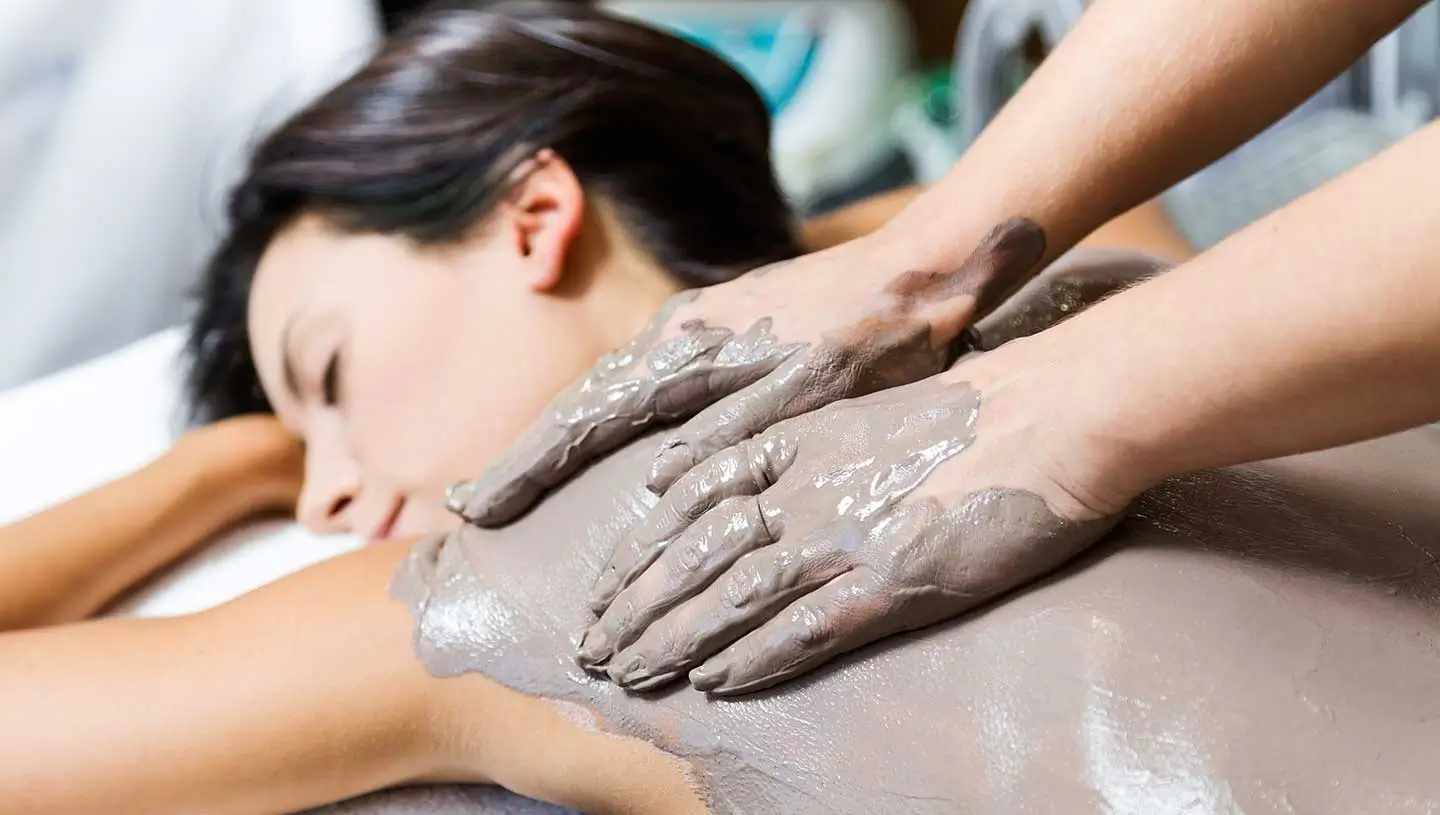Imagine sinking into a warm, gooey embrace of therapeutic bliss—a mud bath. This article is your ultimate guide to the incredible world of mud baths. Whether you’re a seasoned mud bather or a curious newcomer, we’ve got you covered. Mud baths offer not only relaxation but also a myriad of health benefits.

What Is a Mud Bath?
A mud bath is a spa treatment that involves submerging your body in warm, mineral-rich mud. These muds can be found in natural springs or specially designed spa facilities. It’s like Mother Nature’s own therapeutic wonder.
A mud bath involves soaking in a mixture of peat, water, and volcanic ash, offering an incredibly relaxing and often uplifting experience. This detoxifying therapy has ancient origins, traced back to the practices of ancient Greeks and the Wappo tribe in present-day California due to its therapeutic benefits. Historical figures like Napoleon and Cleopatra incorporated mud baths into their beauty routines. If you’re new to mud baths, fret not; we have some fundamental tips and advice for your first experience.
The Benefits of a Mud Bath
- Mud baths, with their elevated temperature, draw out impurities and toxins from the skin, effectively nurturing it. This detoxification process results in softer, rejuvenated skin.
- A notable advantage of mud baths lies in their calming effects. As mud possesses natural cooling properties, this therapy is frequently recommended by naturopaths and alternative healers to manage stress, sleep disorders, and even anxiety.
- Mud baths exhibit potent physical and chemical properties. Immersing oneself in these baths can aid in alleviating symptoms of various skin conditions like psoriasis, eczema, and rosacea. The mineral-rich mud’s regenerative and antiseptic properties assist in regulating endocrine disorders, potentially preventing and treating acne from within, and promoting skin healing.
- Immersion in mud and its minerals can help ease aches and muscle pains by relaxing sore muscles and joints. Research has demonstrated that mud baths may enhance the nervous system’s balance, benefiting individuals with conditions like spondylitis, rheumatoid arthritis, chronic rheumatoid arthritis, spinal pain, musculoskeletal disorders, and peripheral neuropathies.
- The sulfur present in mud is purported to decelerate the aging process by shielding against the detrimental effects of pollution and radiation.
- Mud possesses anti-inflammatory properties. Zinc helps prevent inflammation, while magnesium salts alleviate inflammatory skin and joint disorders.
Different Kinds Of Muds Used For Mud Baths

Certain regions have the ideal geological conditions to produce mineral-rich mud, including magnesium, sodium, and sulfur. Various types of mud baths are available, containing common minerals like sulfur, zinc, bromide, and magnesium, alongside potential additives like peat, volcanic ash, or specific salts based on the region. Mud baths originate from various sources:
- Lakes, like Romania’s Lake Techirghiol, known as ‘moor mud,’ are derived from ancient lakes in peaty European regions. This mud contains sodium, chlorine, potassium, calcium, and sulfur, replenishing nutrients and benefiting skin conditions such as arthrosis, psoriasis, dermatitis, eczema, respiratory diseases, and intestinal disorders.
- Saltwater seas, such as the Dead Sea in Jordan and Israel, offer salt-heavy mud rich in magnesium, calcium, potassium, and iron, known for its positive effects on skin disorders.
- Hot springs, like Calistoga in Napa Valley, California, feature mud with volcanic ash, providing a nourishing treatment for skin cells when combined with the mineral water from nearby hot springs.
- Mud volcanoes, exemplified by El Totumo in Colombia, result from geological processes over many years, comprising a mixture of volcanic mud and thermal water. Volcanic mud primarily contains mineral salts like sulfur, magnesium, and zinc, offering exfoliating and anti-inflammatory properties.
Choose your therapy based on the specific qualities of the mud you desire.
Things To Remember During Mud Baths

Temperature: Note that the mud will typically be maintained around 100 – 104 degrees F (38 – 40 degrees Celsius), similar to a hot tub, to boost body circulation.
Clothing: Depending on the location, you might be asked to remove clothing for better mud contact to draw out toxins through pores and lymph nodes. Alternatively, wearing a bathing suit, discardable underwear, or shorts and a t-shirt is acceptable.
Entering the Mud: Ease into the mud slowly due to its temperature. At a spa, an attendant can assist with comfort. In nature, you won’t sink; your body will float, offering relaxation. Ensure complete submersion up to your chin.
Avoiding Eyes and Mouth: In a spa, inquire about the mud’s type and hygiene. If not deeply immersed, apply mud generously on exposed skin, avoiding eyes and mouth. Dry in the sun and observe others for application techniques.
Traditional Time: Even when coated rather than immersed, limit exposure to 15-30 minutes. Self-monitor time in remote locations.
Rinsing: A thorough rinse without soap suffices; resume regular showers post-mud bath. If having multiple treatments, opt for the mud bath before a massage.
Odor: Expect a slight odor due to the mud’s sulfur content, rich in essential minerals.
Medical Restrictions: Individuals with specific medical conditions—pregnancy, high/low blood pressure, heart conditions, skin infections, or heat sensitivity—should consult a doctor before mud therapy.
Frequently Asked Questions (FAQs)
Is a mud bath safe for everyone?
Mud baths are generally safe, but you must consult a doctor if you have any underlying health concerns or skin conditions. Pregnant women and people with open wounds or infections should avoid mud baths.
How long should I stay in a mud bath?
The recommended duration is typically 20-30 minutes, but you should always listen to your body. If you feel uncomfortable, it’s best to exit the bath.
Can I take a mud bath if I have sensitive skin?
Mud baths can be beneficial for sensitive skin, but it’s essential to choose spas with mild, natural mud and avoid prolonged exposure.
How often can I take a mud bath?
The frequency of mud baths depends on individual preferences and needs. Some enjoy them monthly, while others indulge on special occasions.
Mud baths offer an enchanting blend of relaxation and health benefits, with mineral-rich mud working wonders for your skin and overall well-being. Unwind, rejuvenate, and detoxify in the warm embrace of nature’s therapeutic wonder. Whether you’re seeking relief from joint pain, skin rejuvenation, or a stress-free escape, a mud bath could be your answer. So, go ahead, pamper yourself, and experience the magic of mud!
This article serves to explore the nuances and benefits of immersing yourself in a Mud Bath body treatment experience. Please note that we do not provide this treatment, and the information provided is for reference only. For details on our available range of services, you may visit the L Spa Da Nang website or contact us now!!!
______
L Spa
- Address: 05 An Thượng 4, Bắc Mỹ Phú, Ngũ Hành Sơn, Đà Nẵng 550000
- Phone: 0905 017 047 | 0236 7300595
- Kakao ID: lspadanang
- WhatsApp: +84905017047
- Email: [email protected]
- Fanpage: L Spa

